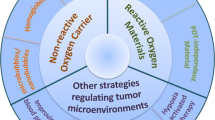Abstract
During the process of photodynamic therapy (PDT), problems arise such as stasis or occlusion of microvasculature, tumor oxygen depletion, and photosensitizer bleaching. This study shows that the first problem could be reduced by using a lower fluence rate light source in PDT. Microvasculature damage was studied experimentally in hematoporphyrin derivative–mediated PDT against light fluence rate, and, to some extent, less microvasculature damage was induced under 75 mW/cm2 illumination than under 150 mW/cm2. Histology of vessels at the end of PDT showed that vessel damage could be observed in both groups, indicating that the microvasculature would eventually be damaged as long as the administration of light fluence was sufficient and regardless of the illuminating fluence rates. Thus microvasculature damage induced by low fluence rate illumination could also be effective in tumor control after PDT. The cell-killing experiment was performed in vitro and designed so that cell-killing rate was influenced only by light characteristics. The higher cell-killing rate caused by 75 mW/cm2 illumination indicated that lower fluence rate light could enhance the light absorbency or decrease the bleaching of photosensitizer.



Similar content being viewed by others
Abbreviations
- BSA:
-
Bovine serum albumin
- HpD:
-
Hematoporphyrin derivative
- OD:
-
Optical density
- PDT:
-
Photodynamic therapy
- PO2:
-
Partial pressure of oxygen
- RBCCD:
-
RBC column diameter
- ROS:
-
Radical oxygen species
References
Thomas JD, Charles JG, Barbara WH, Giulio J, David K, Mladen K, Johan M, Qian P (1998) Photodynamic therapy. J Natl Cancer Inst 90:889–905
Rosenthal DI, Glatstein E (1994) Clinical applications of photodynamic therapy. Ann Med 26:405–409
Brian WP, Lothar L, Michael SP, Brian CW, Tayyaba H (1997) Absorbed photodynamic dose from pulsed versus continuous wave light examined with tissue-simulating dosimeters. Appl Opt 36(28):7257–7269
Curnow A, Haller JC, Bown SG (2000) Oxygen monitoring during 5-aminolaevulinic acid induced photodynamic therapy in normal rat colon comparison of continuous and fractionated light regimes. J Photochem Photobiol B Biol 58:149–155
Henderson BW, Busch TM, Vaughan LA, Frawley NP, Babich D, Sosa TA, Zollo JD, Dee AS, Cooper MT, Bellnier DA, Greco WR, Oseroff AR (2000) Photofrin photodynamic therapy can significantly deplete or preserve oxygenation in human basal cell carcinomas during treatment, depending on fluence rate. Cancer Res 60:525–529
Foster TH, Murant RS, Bryant RG, Knox RS, Gibson SL, Halif R (1991) Oxygen consumption and diffusion effects in photodynamic therapy. Radiat Res 126:296–303
Schunck T, Poulet P (2000) Oxygen consumption through metabolism and photodynamic reactions in cell cultured on microbeads. Phys Med Biol 45:103–119
Hendersonx A, Busch T, Oseroff AR (1998) Effects of fluence rate on tumour oxygenation and vascular responses to photodynamic therapy (PDT). In: INABIS ’98—5th Internet world congress on biomedical sciences at McMaster University, Canada, 7–16 December 1998, invited symposium
Sitnik TM, Hampton JA, Henderson BW (1998) Reduction of tumour oxygenation during and after photodynamic therapy in vivo: effects of fluence rate. Br J Cancer 77:1386–1394
Foster TH, Hartley DF, Nicholas MG, Halif R (1993) Fluence rate effects in photodynamic therapy of multicell tumour spheroids. Cancer Res 53:1249–1254
Veenhuizen RB, Stewart FA (1995) The importance of fluence rate photodynamic therapy: was there a parallel with ionising radiation dose rate effects? Radiother Oncol 37:131–135
Langmack K, Mehta R, Twyman P, Norris P (2001) Topical photodynamic therapy at low fluence rates—theory and practice. J Photochem Photobiol B Biol 60:37–43
Fingar VH, Kik PK, Haydon PS, Cerrito PB, Tseng M, Abang E, Wieman TJ (1999) Analysis of acute vascular damage after photodynamic therapy using benzoporphyrin derivative (BPD). Br J Cancer 79(11–12):1702–1708
Fingar VH, Wieman TJ, Wiehle SA, Cerrito PB (1992) The role of microvascular damage in photodynamic therapy: the effect of treatment on vessel constriction, permeability and leukocyte adhesion. Cancer Res 52:4914–4921
Wang I, Andersson-Engels S, Nilsson GE, Wardell K, Svanberg K (1997) Superficial blood flow following photodynamic therapy of malignant non-melanoma skin tumours measured by laser Doppler perfusion imaging. Br J Dermatol 136:184–189
Webber J, Kessel D, Fromm D (1997) Side effects and photosensitization of human tissues after aminolevulinic acid. J Surg Res 68:31–37
Tromberg BJ, Orenstein A, Kimel S, Barker SJ, Hyatt J, Nelson JS, Berns MW (1990) In vivo tumour oxygen tension measurements for the evaluation of the efficiency of photodynamic therapy. Photochem Photobiol 52:375–385
Sitnik T, Henderson BW (1998) The effect of fluence rate on tumour and normal tissue responses to photodynamic therapy. Photochem Photobiol 67:462–466
Robinson DJ, de Bruijn HS, van der Veen N, Stringer MR, Brown SB, Star WM (1998) Fluorescence photobleaching of ALA-induced protoporphyrin IX during photodynamic therapy of normal hairless mouse skin: the effect of light dose and irradiance and the resulting biological effect. Photochem Photobiol 67:140–149
Acknowledgements
The authors thank Professor Ying Gu for assistance with the experiments.
Author information
Authors and Affiliations
Corresponding author
Additional information
An erratum to this article can be found at http://dx.doi.org/10.1007/s10103-005-0331-4
Rights and permissions
About this article
Cite this article
Xu, T., Li, Y. & Wu, X. Application of lower fluence rate for less microvasculature damage and greater cell-killing during photodynamic therapy. Lasers Med Sci 19, 150–154 (2004). https://doi.org/10.1007/s10103-004-0310-1
Received:
Accepted:
Published:
Issue Date:
DOI: https://doi.org/10.1007/s10103-004-0310-1




